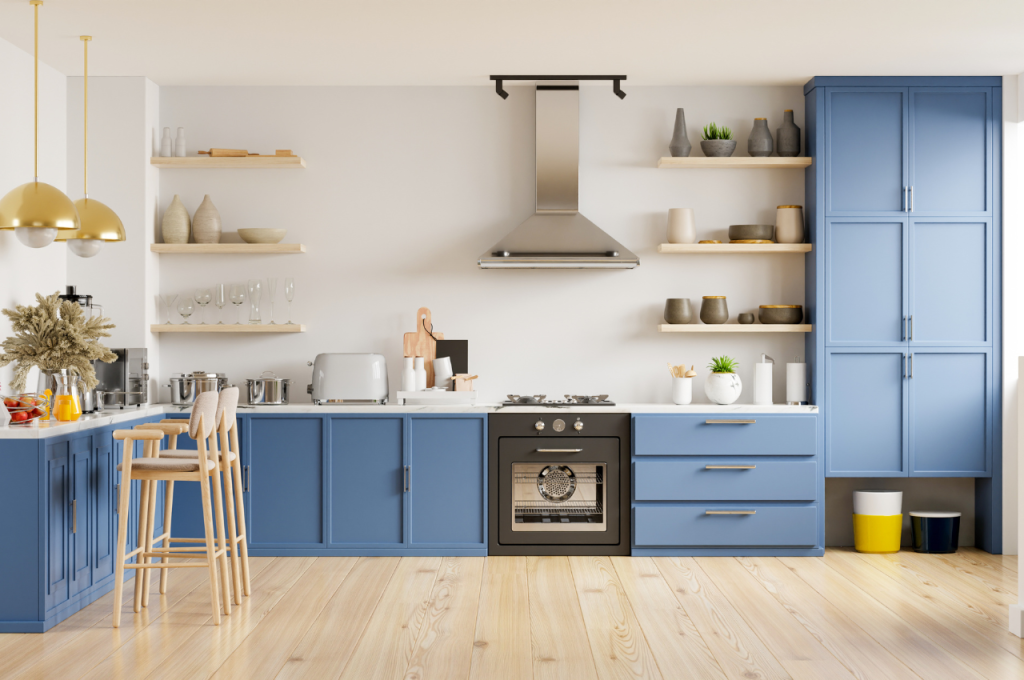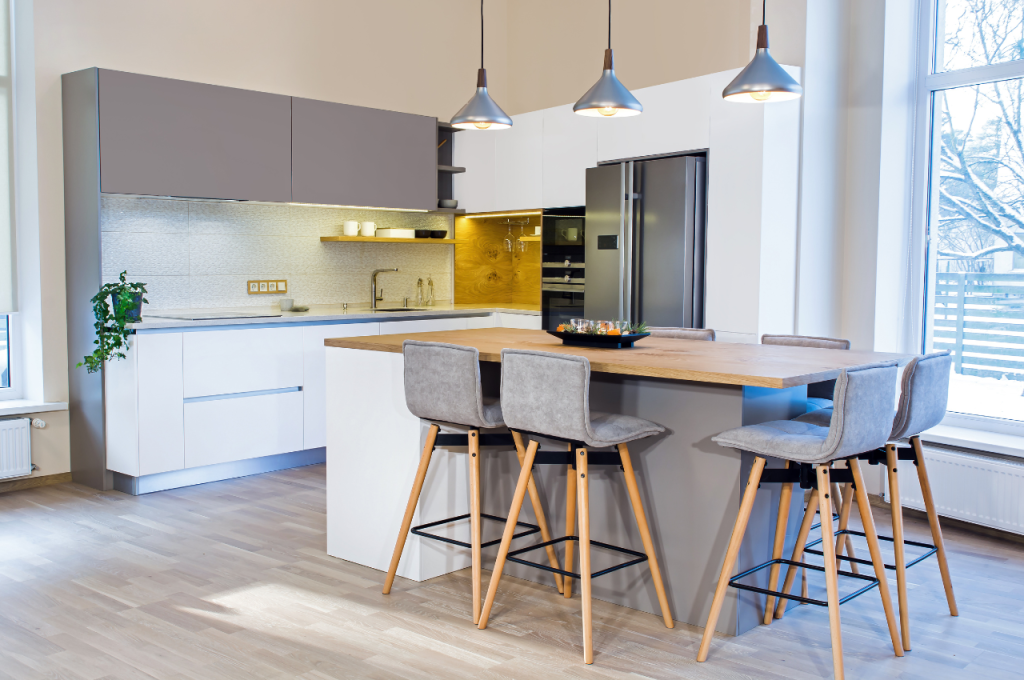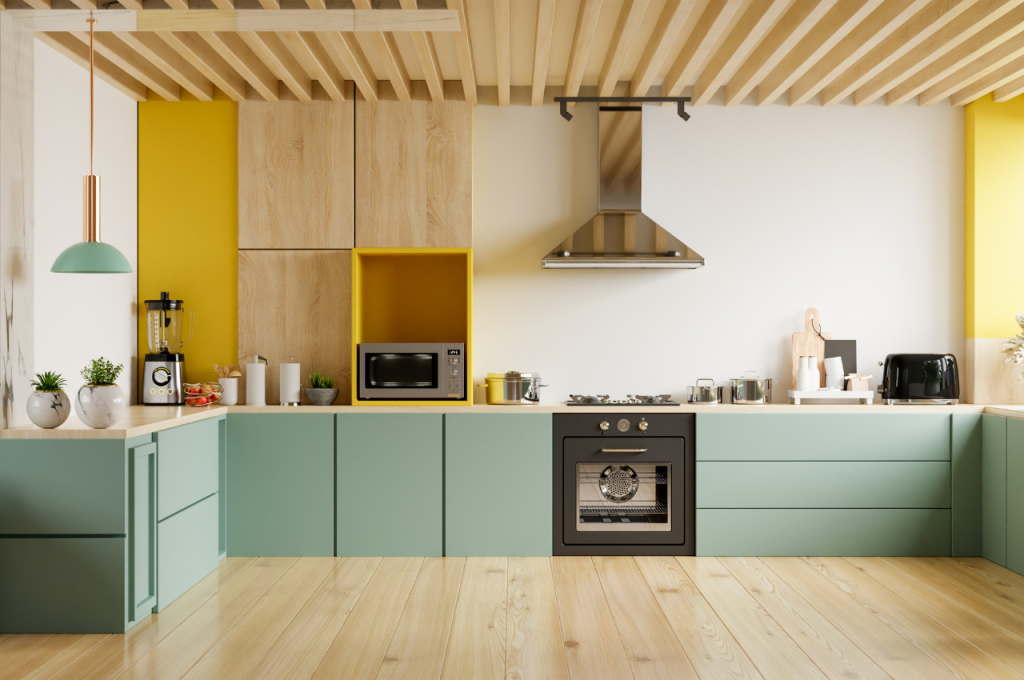The interior design for the kitchen involves creating a functional and aesthetically appealing space that reflects the homeowner’s style and meets their needs. Creating the perfect kitchen design requires a balance of functionality and beauty.
From selecting the right cabinetry, countertops, and flooring to choosing the perfect lighting and color scheme, there are many elements to consider. Whether it’s a modern, minimalist look or a cozy, farmhouse-inspired space, the design should enhance the overall functionality of the kitchen while also reflecting the homeowner’s taste.
With the right interior design, the kitchen can become the heart of the home, where family and friends gather to create memories and share meals.
The Importance of Kitchen Design
The kitchen is more than just a place to prepare meals, it’s the heart of the home, where families gather, memories are made, and conversations flow freely. Thoughtful kitchen design goes beyond aesthetics, focusing on functionality, efficiency, and comfort to create a space that enhances your home and enriches your lifestyle.

Creating Functional Spaces
The layout and organization of a kitchen play a crucial role in its functionality. Efficient space utilization, convenient storage solutions, and a well-thought-out work triangle are essential elements that contribute to a functional kitchen design. A functional kitchen promotes a smooth workflow, making meal preparation and cooking more enjoyable and less stressful.
Enhancing Aesthetic Appeal
Aesthetically pleasing kitchen design can significantly elevate the overall ambiance of your home. From carefully selecting color palettes, materials, and textures to integrating stylish fixtures and finishes, a well-designed kitchen enhances the visual appeal of the space. Aesthetic considerations extend beyond mere visual appeal; they also contribute to a welcoming and comfortable environment, making the kitchen a place for both culinary creativity and social gatherings.
Key Elements to Consider
When designing your kitchen, there are key elements that are crucial to creating a functional and aesthetically pleasing space. Consider the following elements to ensure a well-designed kitchen:
Layout and Space Planning
Optimal layout and space planning are vital for a functional kitchen. Ensure that work zones flow smoothly to enhance efficiency.
Cabinetry and Storage Solutions
Select cabinetry that suits your design style and provides ample storage solutions. Maximize space with smart storage options.
Appliances and Fixtures Selection
Carefully choose appliances and fixtures that complement your design. Select energy-efficient options for sustainability and savings.
Color Palette and Material Selection
The color palette of your kitchen plays a key role in creating the desired ambiance. It’s important to choose a color scheme that not only complements your style but also enhances the functionality of the space.
When selecting the right color scheme, consider the size and natural light of your kitchen. Light colors such as whites, creams, and pastels can make a small kitchen appear larger and brighter. On the other hand, dark colors like navy blue, charcoal, and deep greens can add a touch of elegance and warmth to larger kitchens.
Additionally, you can create visual interest by incorporating accent colors. These can be brought in through kitchen accessories, backsplashes, or even painted cabinetry. Accent colors can add personality and create a focal point in your kitchen.
When it comes to material selection for your kitchen, durability, and style are essential factors to consider. The kitchen is a high-traffic area prone to spills, heat, and frequent cleaning, so it’s important to choose materials that can withstand everyday wear and tear.
Table: Popular Kitchen Materials and Their Pros And Cons
| Material | Pros | Cons |
| Granite | Durable, heat-resistant, and adds value to your home | Requires regular sealing, can be expensive |
| Quartz | Non-porous, resistant to stains and scratches | Can be more expensive than other materials |
| Stainless Steel | Modern and sleek look, easy to clean | Can scratch easily, shows fingerprints |
| Hardwood | Warm and inviting, can be refinished | Requires regular maintenance, vulnerable to water damage |
Ordered List: Tips For Material Selection
- Consider the functionality and durability of the material
- Look for materials that are easy to clean and maintain
- Take into account your style and the overall theme of your kitchen
- Compare the pros and cons of different materials before making a decision
- Consider the cost and your budget when choosing materials
By understanding the importance of color palette and material selection, you can create a beautiful and functional kitchen that reflects your style and enhances your cooking experience. So go ahead, and choose the perfect color scheme and durable materials to transform your kitchen into a space you’ll love spending time in!
Lighting and Ambient Enhancement
In interior design for kitchens, lighting plays a crucial role in creating the perfect atmosphere and enhancing the overall ambiance. The right lighting not only illuminates the space but also adds warmth, depth, and character. This section will explore two key aspects: maximizing natural light and artificial lighting options, to help you transform your kitchen into a beautifully lit and inviting space.
Maximizing Natural Light
Introducing natural light into your kitchen can significantly enhance its visual appeal and make it feel more spacious. Here are some tips to maximize the natural light in your kitchen:
- Position your kitchen near windows or glass doors to allow ample sunlight to flood in.
- Use light-colored or sheer curtains that can be easily drawn back to let in maximum sunlight.
- Install reflective surfaces, such as mirrors or glossy tiles, to bounce natural light around the space.
- Opt for translucent window treatments, like frosted glass or window films, that offer privacy without compromising light.
- Trim any nearby trees or bushes that may obstruct sunlight from streaming into your kitchen.
By incorporating these simple techniques, you can create a bright and airy kitchen that harnesses the beauty of natural light.
Artificial Lighting Options
While natural light is ideal, artificial lighting is indispensable for combating dim areas and creating a cozy ambiance during evenings or cloudy days. Here are some popular artificial lighting options to consider for your kitchen:
| Option | Features |
| Recessed Lighting | – Provides even illumination- Suitable for general and task lighting |
| Pendant Lights | – Adds a decorative touch- Ideal for highlighting specific areas, like kitchen islands or dining nooks |
| Under Cabinet Lighting | – Illuminates countertops and work areas- Enhances kitchen functionality |
| Track Lighting | – Offers flexibility with adjustable fixtures- Ideal for showcasing artwork or accentuating architectural elements |
| Chandeliers | – Adds elegance and sophistication- Perfect for creating a focal point in larger kitchens |
Each of these artificial lighting options brings its own unique benefits and aesthetic appeal. Depending on your kitchen’s size, layout, and personal style, you can mix and match different lighting fixtures to achieve the desired mood and functionality.
Incorporating Functional Design Features
Functional design features are essential in creating a well-designed and efficient kitchen space. By incorporating practical elements into the design, you can enhance the functionality and usability of the kitchen while maintaining a stylish aesthetic.

Ergonomics and Accessibility
Ergonomics in kitchen design focuses on creating a space that is comfortable and efficient to use. Consider ergonomic features such as the height of countertops and the placement of appliances for easier accessibility.
- Install pull-out shelves for easy access to items.
- Opt for adjustable height countertops to cater to users of different heights.
- Include task lighting in work areas to improve visibility and reduce eye strain.
Multi-functional Design Elements
Integrating multi-functional design elements can maximize the functionality of your kitchen while optimizing space usage. Look for versatile features that serve multiple purposes to make the most of your kitchen layout.
- Choose kitchen islands with built-in storage to minimize clutter.
- Opt for dual-purpose furniture such as dining tables that can also serve as a workspace.
- Consider installing sliding doors or partitions to separate areas when needed.
Personalizing Your Kitchen Space
When it comes to creating a kitchen space that truly reflects your personality and taste, personalization is key. Your kitchen should be a reflection of your individual style and functional needs, creating a space that’s not only beautiful but also practical and comfortable.
Incorporating Personal Style
Creating a kitchen that aligns with your style involves integrating elements that speak to your tastes and preferences. Whether you lean towards modern, traditional, eclectic, or minimalist designs, incorporating personal style into your kitchen can be achieved through a careful selection of colors, materials, and furniture. Choose cabinetry, countertops, and backsplash options that resonate with your aesthetic, and layer in personal touches through accessories and styling details.
Adding Unique Decorative Touches
Every kitchen can benefit from unique decorative touches that elevate the space and make it feel distinctly yours. This can be achieved through carefully curated decorative items such as artwork, vintage kitchenware, or heirloom pieces that add character and charm to the room. Embracing decorative touches can also involve incorporating personal items, such as framed family recipes or handcrafted ceramics, to infuse your kitchen with sentiment and personality.
Budget-friendly Design Tips
When renovating a kitchen, it’s crucial to strike a balance between style and affordability. With the right strategies, you can achieve a stunning kitchen design without breaking the bank. These budget-friendly design tips will help you transform your kitchen into a stylish and functional space. Let’s explore some insightful ideas to enhance your kitchen’s aesthetic appeal while staying within your budget.
Strategic Investments
Strategic investments in key elements can significantly enhance the overall look and feel of your kitchen. Opt for bold, yet cost-effective updates such as:
- Lighting: Upgrading lighting fixtures can instantly elevate the ambiance of your kitchen. Consider adding statement pendant lights or under-cabinet LED strips for a modern touch.
- Hardware: Swapping out old cabinet knobs and drawer pulls with sleek, contemporary options can rejuvenate the entire space.
- Paint: A fresh coat of paint on cabinets or walls can redefine the kitchen’s aesthetic without incurring hefty expenses.
Diy and Upcycling Ideas
Embracing DIY and upcycling projects can inject personality into your kitchen while keeping costs down. Explore these creative ideas:
- Repurposing Furniture: Consider repurposing an old dresser as a kitchen island or refurbishing a vintage table as a charming dining nook.
- Open Shelving: DIY open shelves using reclaimed wood can create a trendy display area for your kitchen essentials and decor items.
- Statement Backsplash: Transform your kitchen with a unique, self-installed backsplash using affordable materials like peel-and-stick tiles or reclaimed wood.
Seeking Professional Assistance
When it comes to interior design for your kitchen, seeking professional assistance can make all the difference. Designing a kitchen that not only looks aesthetically pleasing but also functions well requires careful planning and expertise. Working with an interior designer and collaborating with contractors can help you achieve your dream kitchen. In this section, we will explore the benefits of hiring an interior designer and the importance of collaborating with contractors.
Hiring An Interior Designer
Hiring an interior designer is a wise investment when it comes to transforming your kitchen. These professionals have the knowledge and experience needed to create a space that not only reflects your style but also maximizes functionality. Here are some reasons why hiring an interior designer for your kitchen design project is a great idea:
- Expertise: Interior designers have extensive knowledge of the latest trends, design techniques, and materials. They can provide valuable insights and make informed decisions that suit your specific needs.
- Space Optimization: An interior designer can help you make the most of your kitchen space by optimizing the layout, ensuring efficient workflow, and maximizing storage.
- Personalization: Interior designers work closely with you to understand your preferences, lifestyle, and needs. They can translate your vision into a well-designed kitchen that reflects your unique style.
- Budget Management: Hiring an interior designer can help you stay within your budget. They have access to a wide range of suppliers and can source materials and products at competitive prices.
Collaborating With Contractors
In addition to working with an interior designer, collaborating with contractors is essential for a successful kitchen remodel. Contractors play a key role in executing the design plan and ensuring that the project is completed smoothly. Here are some reasons why collaborating with contractors is important:
- Technical Knowledge: Contractors have the technical expertise and skills required to carry out the construction and installation aspects of your kitchen remodel. They have a deep understanding of building codes, regulations, and industry standards.
- Efficient Execution: Collaborating with contractors ensures that the design plan is implemented effectively and efficiently. They will coordinate with various tradespeople to ensure that the project progresses smoothly and is completed on time.
- Quality Assurance: Contractors pay careful attention to detail and ensure that the workmanship is of the highest quality. They have relationships with reliable suppliers and can source materials that meet your specifications.
- Budget Control: Contractors can help you manage costs by providing accurate estimates and ensuring that the project stays within budget. They will also handle any unexpected issues that may arise during the construction process.
By hiring an interior designer and collaborating with contractors, you can turn your kitchen into a functional and beautiful space that exceeds your expectations. Their expertise, knowledge, and attention to detail will ensure a successful kitchen design project.

Conclusion
Elevate your kitchen’s style with these interior design tips. Create a functional and aesthetic space that reflects your personality. From colors to lighting, every element plays a vital role. Let your kitchen be a true reflection of your taste and lifestyle.
Transform your kitchen into a beautiful sanctuary today.

